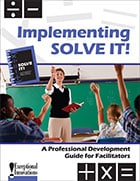
Solve It! is a structured approach that incorporates effective instructional strategies for teaching math word problems.
Solve It! is a structured approach that incorporates effective instructional strategies for teaching math word problems, including the following top 10:
- Cueing/Prompting
- Generalization
- Immediate and Corrective Feedback
- Modeling
- Verbal Rehearsal
- Maintenance
- Overlearning
- Positive Feedback
- Mastery Learning
- Mnemonics
Following is a quick reference guide for strategies 6–10 of the Solve It! top 10 strategies. Each features a definition and a vignette showing how the strategy is used when teaching the Solve It! approach to solving math word problems. (Click here to read more about strategies 1–5.)
6. Maintenance Strategy
Definition: Perform a learned task or use an acquired strategy over time. For example, students who learn and apply the Solve It! approach successfully during instruction continue to use it successfully when explicit instruction is no longer provided. Distributed practice is important to maintain performance over time.
Vignette: Ms. Williams provides practice using Solve It! problems, problems from the math text, and practice problems from the state assessment test. She gives a test of 10 math problems every three weeks. If students decline in performance, she provides them with a booster session.
7. Overlearning Strategy
Definition: The ability to learn a skill or behavior successfully and then complete the task or use the strategy automatically. For example, students who learn and apply the Solve It! approach successfully during instruction continue to adapt and adjust their application depending on the difficulty level of the problem without thinking about the strategy steps.
Vignette: Ms. Williams continues to monitor students’ work after they learned and applied Solve It! correctly. She notes how students use the approach for problems of different difficulty levels. Throughout the school year, she models the processes that present difficulty to students. For example, she makes schematic representations of the problems and uses mental arithmetic to estimate. She monitors how effective and efficient students are as they solve problems. In this way, Ms. Williams ascertains whether students have internalized the approach and can use it appropriately and automatically.
8. Positive Feedback Strategy
Definition: Provide explicit and positive responses to specific behaviors. For example, students are praised for drawing a visual representation of a math problem that shows the relationships among the problem parts. The behaviors that are praised are labeled and described.
Vignette: Ms. Williams observes Elaine using visual (schematic) representation to make sure that she shows the relationships among the problem parts.
Elaine says, “Then I will visualize by making a drawing or a diagram.”
SAY: Make a drawing or a diagram that shows the relationship among the problem parts. Hmm, maybe a box. Inside the box, I will write 30 x $8, that’s one part, and 140 x $.50, the other part. Don’t forget the decimal or cent sign. I will join them with “and.” Then I will write a question mark above it to say that I need to add what’s in the box to get the total amount he made. [Elaine puts the following numbers in a box: 30 x $8 and 140 x $.50.]
ASK: Does the picture fit the problem? Yes, I think it does. All that information is needed to find how much he made.
CHECK: Check the picture against the problem information. Let me make sure I wrote the correct numbers: 30 x $8 and 140 x $.50. Yes, I did.
Ms. Williams says, “Elaine, you did a super job of developing a visual representation of the problem. You created a visual to show that you needed three steps to solve the problem. What are the three steps?”
Elaine replies, “Multiply 30 by 8 and then multiply 140 by 50 cents and then add the two answers to get the final answer.”
Ms. Williams says, “Excellent representation; that leads you to your hypothesis or your plan for solving the problem. Does everyone understand Elaine’s visual representation? If not, let us know and we can explain. This is Elaine’s representation; your representation could be different but still correct. Does anyone have a different representation?” Ms. Williams continues to provide positive and corrective feedback to other students.
19. Mastery Learning Strategy
Definition: Perform a task correctly or use a strategy appropriately and meet a certain criterion for acceptable performance.
Vignette: Ms. Williams monitors students’ performance on Solve It! progress checks. Students who achieve mastery (i.e., score at least seven problems correct on at least three of four progress checks of 10 math problems each) work in small groups solving novel problems while Ms. Williams assists the remaining students as they work toward mastery. She knows that she may have to adjust the criterion for some students (e.g., seven of 10 correct on two of the four progress checks).
10. Mnemonics Strategy
Definition: A strategy or technique that helps learners remember how to perform a task or apply a strategy. The acronym RPV-HECC (read, paraphrase, visualize, hypothesize, estimate, compute, and check) is a mnemonic strategy to help students remember the Solve It! routine.
Vignette: Ms. Williams instructs students to use RPV-HECC to help them remember the seven steps of the Solve It! approach. She knows that the acronym will fade away when the steps are committed to memory. When students are practicing the Solve It! approach, she cues students using the acronym.
Ms. Williams says, “R.” Students in unison say, “Read for understanding.”
Ms. Williams says, “P.” Students in unison say, “Paraphrase your own words.”
Ms. Williams continues until the students complete the RPV-HECC acronym letters.
Read about strategies 1–5 here.
Learn More
 Implementing Solve It! A Professional Development Guide for Facilitators contains numerous activities and tools for understanding Solve It!. While teachers can learn the Solve It! approach from the manual, learning is often enhanced by studying the Solve It! components in more depth.
Implementing Solve It! A Professional Development Guide for Facilitators contains numerous activities and tools for understanding Solve It!. While teachers can learn the Solve It! approach from the manual, learning is often enhanced by studying the Solve It! components in more depth.
The facilitator’s guide provides a variety of professional development activities that can be used in workshops, by teachers working alone or in teams, in coaching sessions, and so on. The activities correspond with the elements of the Solve It! approach and are organized as chapters in the guide that include:
- Understanding the Solve It! Approach. This chapter provides suggestions for introducing Solve It!.
- Becoming Skilled in the Solve It! Process. This chapter provides suggestions for understanding and developing the cognitive strategy instruction that forms the basis for the Solve It! approach.
- Becoming Skilled in the Solve It! Instructional Components. This chapter provides suggestions for developing key instructional strategies that are used when presenting Solve It! to students.
- Learning How to Use the Solve It! Assessments.This chapter provides suggestions for administering, interpreting, and using the Solve It! assessments.
- Putting It All Together—Implementing Solve It!. This chapter provides suggestions for organizing Solve It!. Attention is given to supporting implementation.
For more information, see https://www.exinn.net/solve-it/implementing-solve-it-2/.
